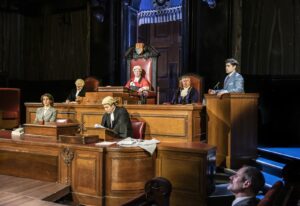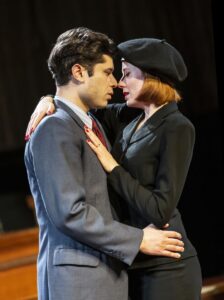It’s a Mystery why Witness For The Prosecution is a Success. Here are the Clues
★★★

It’s been on since 2017 but somehow I never quite got round to seeing Witness For The Prosecution. To be honest, there was a little bit of prejudice involved. Partly, much as I enjoy an Agatha Christie novel, I have seen her plays before and found them a little stilted. Secondly, it seemed a bit gimmicky to be presenting the play in the old County Hall. The mystery is, it works. So, I’ve engaged my little grey cells and I think I’ve solved the mystery of why it’s a success.
The first clue is the venue. County Hall, near Waterloo, and by the Thames, is a magnificent building. It was the home of the old London Council. Just entering is a stunning experience. The auditorium for Witness For The Prosecution is the former debating chamber. Consequently, it has very comfortable seating, with a terrific view- you wouldn’t expect anything less for the politicians running the capital city. It’s almost worth going to see the play just to sit in the chamber.
Although you can regard setting the play there as a gimmick, it may be more generous to call it ‘site specific’. The important thing is, it works. That’s partly because the auditorium has the grandeur you associate with the Old Bailey, where most of the play is set, and partly because the layout of the chamber with two sides facing one another matches the adversarial nature of a court case, which is the main subject of the play.
Then there’s the play itself. It starts with a scene in the chambers of a defence barrister Sir Wilfrid Robarts. This seems to confirm your worst fears. In 1953, when Agatha Christie wrote Witness For The Prosecution, theatre was changing- it’s the same year that Samuel Beckett’s Waiting For Godot premiered, and three years before John Osborne‘s ‘kitchen sink’ drama Look Back In Anger opened- both of which are being revived in the West End this year, by the way. But the style of this play looks backward rather than forward. The people are middle class, and everyone speaks as they ought to, rather than as they would. The dialogue is like any standard so-called ‘drawing room’ play- or film- from the early part of the century.
Then, we are taken to the criminal court. The place where to this day, they still behave like people from the 1950s, or 1850s even.
The clue here as to why Witness of The Prosecution is a success against the odds is in the talent of the creators of this production, director Lucy Bailey and designer William Dudley, to see the potential for this old building as a setting for a play mainly taking place in a courtroom. Chris Davey’s lighting is pretty impressive too- emphasising drama and contrast.
And the final clue: Agatha Christie herself. Now her characters may be ciphers, in the sense that they exist purely in the service of the twisty legal drama and don’t have a lot of depth, but the plot is grippingly good. It’s not just a clever story full of mystery and twists (although it is) but it’s also supplied with a lot of realistic detail. Ms Christie studied many court cases and had the help of a barrister to make sure the legal details are accurate.

That helps a lot. But so does her story. We begin with Leonard Vole, a handsome cockerney lad accused of murder. He protests his innocence and we believe him but he is clearly too honest and too naive for his own good. The cast changes every so often but currently George Jones plays him with conviction – sorry, that’s probably an inappropriate word, better to say, ‘convincingly’. Leonard had befriended an older well-off woman who was found dead one evening not long after he had visited her, and it turns out she’s left him her fortune.
It’s a challenge to defend him but Sir Wilfrid, with humour and a degree of arrogant self confidence, decides to take on the case. Oliver Boot nails the role and dominates the stage, as he should. Sir Wilfrid and Leonard’s concerned solicitor Mr Mayhew, played by Ewen Cummins, subsequently discuss the case with condescension, patronising humour, and a dash of misogyny.
And the case goes well. A benign and predictably stuffy judge Mr Justice Wainwright is played by David Killick with authority and a twinkle in his eye, as he watches Sir Wilfrid run rings around the exasperated prosecution lawyer Mr Myers, played by Gyuri Sarossy who keeps bouncing back like a punch drunk fighter. He destroys witness after witness including the forensic scientist Dr Wyatt played by Nicholas Chambers, and the vindictive housekeeper Janet MacKenzie, given an scene stealing turn by Veronica Roberts. Finally, Leonard’s wife appears as a witness for the prosecution and, under oath to tell the truth, demolishes Leonard’s alibi. It’s a bravura performance by Meghan Treadway.
Why has she done this? The second act reveals all. And you realise as twist follows twist just how much Ms Christie has misled you, maybe even taken advantage of your expectations of a traditional ‘drawing room’ play. You see that, dammit, just like the people who meet her character Miss Marple, you’ve underestimated the Queen of Crime.
It turns out to be a very satisfactory evening, well put together, well acted and well produced in a striking venue. Mystery solved.
Witness For The Prosecution can be seen at the County Hall in London for the foreseeable future.
Paul paid for his ticket.
Click here to watch this review on the YouTube channel Theatre Reviews With Paul Seven
I hope…